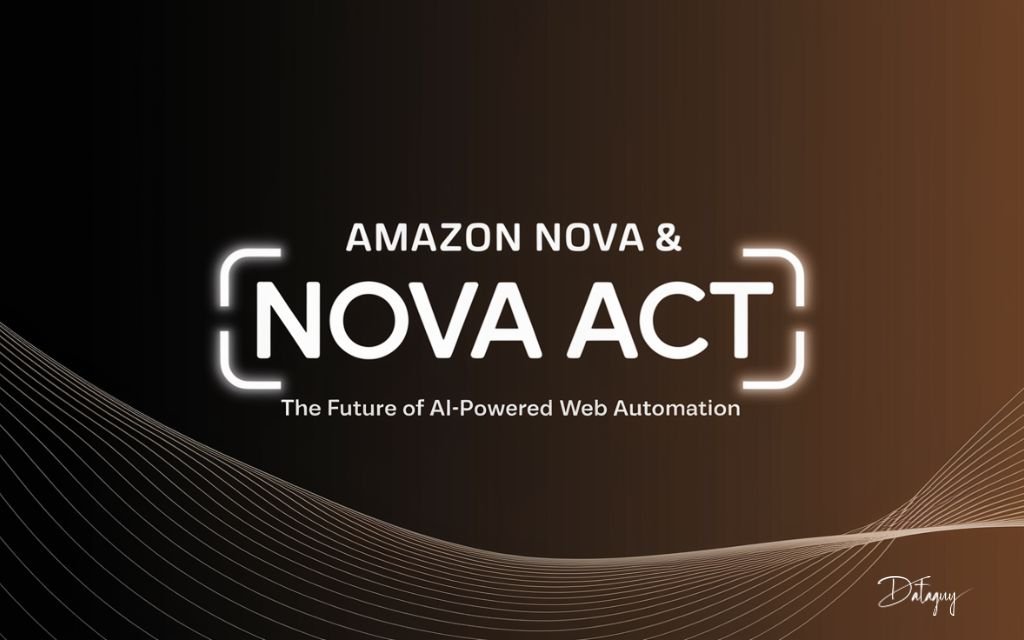Insights Index
ToggleAmazon Nova & Nova Act: A Bold Leap into Agentic AI
Introduction
Amazon has just made a significant leap into the frontier AI space with the launch of Amazon Nova, a suite of foundation models, and Nova Act, an AI agent capable of performing autonomous actions in web browsers.
This move positions Amazon as a serious competitor in the rapidly evolving landscape of agentic AI, challenging established players like OpenAI and Anthropic.
Let’s dive into what makes these new offerings special and how they stack up against the competition.
What is Amazon Nova?
Amazon Nova represents a comprehensive suite of foundation models designed to deliver cutting-edge AI capabilities with exceptional performance. The Nova family includes:
- Text Generation Models: Nova Micro, Lite, and Pro models, each optimized for different performance and efficiency needs
- Image Generation: Nova Canvas for creating high-quality images from text prompts
- Video Creation: Nova Reel that transforms text and image inputs into video content
What sets Nova apart is its seamless integration with Amazon Bedrock, allowing AWS customers to deploy these models at scale.
Developers can access these models directly through the nova.amazon.com platform for experimentation and implementation in production environments.
Nova Act: Amazon’s Answer to Agentic AI
Perhaps the most exciting aspect of Amazon’s announcement is Nova Act, an advanced AI agent capable of automating complex web-based tasks. Nova Act represents Amazon’s entry into the competitive field of agentic AI, where it goes head-to-head with OpenAI’s Operator and Anthropic’s Claude.
Key Capabilities of Nova Act
Nova Act excels at performing autonomous tasks in web browsers, including:
- Searching for specific information based on detailed criteria
- Completing shopping transactions with nuanced instructions
- Managing complex workflows like booking reservations
- Handling pop-ups, drop-down menus, and date selections with high accuracy
What makes Nova Act particularly powerful is how it breaks down workflows into atomic commands, such as search and checkout, with detailed instructions for each step. This approach allows for greater precision and reliability in task execution.
Nova Act vs. Competitors: A Performance Comparison
Amazon claims that Nova Act outperforms its competitors in several key benchmarks. Most notably, Nova Act scored an impressive 94% on the ScreenSpot Web Text benchmark, surpassing both OpenAI’s CUA (88%) and Anthropic’s Claude 3.7 Sonnet (90%) in interacting with on-screen text.
| Feature | Amazon Nova Act | OpenAI Operator | Anthropic Claude |
|---|---|---|---|
| Task Automation | Multi-step tasks like shopping, bookings | Repetitive tasks like grocery shopping | General web navigation |
| Workflow Handling | Atomic command breakdown | GPT-4o reasoning and vision | Screen interpretation |
| Benchmark Score | 94% on ScreenSpot | 88% on ScreenSpot | 90% on ScreenSpot |
| Cost Efficiency | Up to 75% cheaper than competitors | No highlighted cost advantages | Standard pricing |
Amazon has emphasized cost efficiency as a key differentiator, claiming that Nova Act is up to 75% cheaper than competitors while maintaining superior performance.
Developer Access through SDK
For developers eager to build with Nova Act, Amazon has released the Nova Act SDK, currently available as a research preview. This SDK enables developers to:
- Create custom agents for specific use cases
- Define workflows with detailed instructions
- Integrate with APIs to enhance reliability
- Control when human intervention is necessary
This accessibility for developers could accelerate adoption and lead to innovative applications across various industries.
Current Limitations of Nova Act
While Nova Act shows tremendous promise, it’s important to acknowledge its current limitations in the research preview stage:
- Browser-Only Interaction: Nova Act cannot interact with applications outside web browsers, limiting its use to browser-based tasks
- Complex Prompt Handling: The agent may struggle with high-level or complex prompts that require nuanced understanding
- Contextual Understanding: Like other AI agents, Nova Act faces challenges in maintaining context across different tasks
- Real-World Testing: While performing well on internal benchmarks, comprehensive real-world testing across diverse scenarios is still needed
Integration with Amazon’s Ecosystem
One significant advantage for Nova Act is its integration into Amazon’s broader ecosystem. The agent is being integrated into Alexa+, which could dramatically extend its reach to millions of Alexa users. This integration could provide Amazon with a unique distribution channel that competitors currently lack.
The Future of Agentic AI
Amazon’s entry into the agentic AI space with Nova Act signals a significant shift in the competitive landscape. As these technologies mature, we can expect to see:
- More reliable automation of complex web-based tasks
- Broader integration into consumer and enterprise applications
- Improved contextual understanding and decision-making capabilities
- Increased competition driving innovation across the industry
Conclusion
Amazon Nova and Nova Act represent a major step forward in Amazon’s AI strategy and a direct challenge to established players in the agentic AI space. With impressive benchmark performance, cost advantages, and integration with Amazon’s vast ecosystem, Nova Act could potentially reshape how we interact with web-based services.
As the technology moves from research preview to broader availability, it will be fascinating to see how developers leverage the Nova Act SDK to create innovative solutions and how Amazon’s competitors respond to this new challenge in the rapidly evolving AI landscape.

